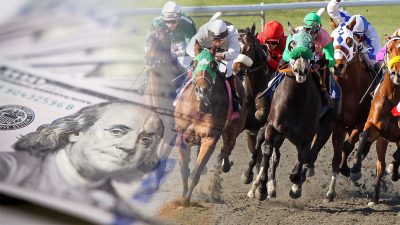The age-old question pondered on many message boards and in the comments sections of many articles is whether someone can make a living by gambling. The dictionary defines gambling as “the act of playing for stakes in hope of winning.”
The key word here is “hope.” As my late Uncle Dutch would say, no matter how much homework and sound handicapping anyone does, horses are people too.
Andy Beyer penned an entertaining book entitled “My $50,000 Year at the Races.” This book discussed his profitable summer of 1977, which if you use the Consumer Price Index (CPI), this would escalate to his $198,214.52 year at the races. But don’t forget, he did this while having a paying gig with the Washington Post. Regardless, that is pretty impressive feat, but can anyone sustain this year after year and make a living gambling full time?
Probably not.
Even the most successful handicappers and bettors I know all have a day job that pays the bills and allows them to fund a bankroll to play the races. When you look at celebrity horseplayers, such as the cast of the short lived series “Horseplayers” on the Esquire network — John Conte sells selections; Matt Bernier was a real estate agent and landed at the Daily Racing Form after the series; Mike Beychok is a political consultant; Peter Rotondo Jr. works for the Breeders’ Cup; Kevin Cox has a nice NYPD pension, was a former jockey agent, and sells his selections; both Lee Davis and Peter Rotondo Sr. are retired traders; and Christian Hellmers has his hands in many pots with some start-up companies. I am not saying that it can’t be done, but like your 401K, most people need to diversify their income, which includes some sort of steady employment.
So what would it take to make a living from playing the races?

Horse Betting Bankroll: Tips To Keep Funds In Great Shape
Bankroll
The biggest factor that keeps anyone from gambling for a living is their bankroll. Most of us are playing with a bankroll that is within our current means of living from a few hundred dollars to a few thousand. Many professional gamblers don’t turn out a profit of greater than 10%, so to make $150,000 profit that would equate to passing $1.5M through the windows! This is assuming that if you played $500 per play, every day during the year, you would need over eight strong plays per day. This would be difficult for the niche horseplayer who perhaps only plays turf sprints or is very particular with their plays. Rebate shops can help to soften the blow, but expenses have to be factored into the equation as well. Do you spend time at the track watching workouts or races? How much does your data cost? If you are trying to do this for a living, how much are your rent/mortgage, car, computer, and other living expenses worth?
Solid Handicapping
Whether it is your own handicapping or a service you use, if it isn’t picking the right horses you aren’t going to win. Last week, I discussed how tracking your bets and handicapping can help you hone in on what may be sabotaging your bankroll. Without picking the right horses and knowing how to play them, you are not going to turn a profit, regardless of the size of your bankroll.
Confidence / Discipline
Stick with the plan. Do your homework. You can’t let emotions get the better of you when looking for action. If it isn’t a race that you have an edge in, don’t get lured into playing with your prime bankroll. We all hit slumps regardless of how sound our handicapping is. The more money you have on the line, the more confident you need to be in your handicapping and decisions.
Money Management
If there was a perfect system for money management, you would think someone may have found the Holy Grail! There are several prevailing methods of money management that have been kicked around by the writers in the handicapping community. Which one is right for you? That depends on how you play.
Some basic popular methods include:
Kelly Criterion
This is one of the most popular and oft-discussed strategies. You are optimizing your wager size on the perceived edge you have on the race based on the fair odds that you have assigned your pick versus the track odds. Tom Ainslie discusses a modern version of the Kelly Criterion in his classic “Ainslie’s Complete Guide to Thoroughbred Racing,” but doubts that many would do it and those that did would do it right. In this situation, your wager size will vary even if two horses meet the same angle that you know has a 50% strike rate based on what their current odds are.
Percentage of Bankroll
This theory is based on the concept that you will play a certain percentage of your bankroll on a horse. Maybe a certain angle provides more of an edge or a higher win percentage than other angles? In that case you can vary the percentage of bankroll you wager based on your confidence in the play. For example, if you have an angle that hits 50% of the time, you may want to play a higher percentage of your bankroll, such as 4% or 5%. On an angle that hits less often, you may elect to use a percentage that is lowered based on the strike rate.
Fixed Wager Size
This follows the idea of the “Percentage Bankroll.” Based on your confidence in a particular angle or type of play, you wager a set amount on that type of play. Some wager types may vary in size from others based on either historical return on investment or strike rate. For example, if you have an angle that you know hits about 50% of the time, you may want to use a fixed bet value of $20 whereas an angle you know hits roughly 25% of the time may be worth a $10 bet or a longshot angle that hits with less frequency may be a $5 wager.
Prime vs. Action Bets
In “Picking Winners,” Andy Beyer talks about allocating a percentage of your bankroll to both prime and action bets. Prime bets are the wagers that you feel most confident in and meet handicapping criteria that leads you to make the wager. Action bets are the bets that you would place based on current odds or conditions that are not part of what your handicapping says are solid bets, but may be worth the risk given the potential payoff. Dave Liftin suggests splitting your bankroll in his book “Expert Handicapping” into 40% overlay win bets and 60% in exotics. Since the greater potential for a larger payout resides in exotic wagers, you must consider what percentage split you would want to make.
Hedging
Bill Heller, in “Overlay, Overlay, How to Bet Horses Like a Pro,” suggests playing enough on a win bet to cover exotic wagers. If you do well with exactas and trifectas then hedging your bets with a win bet can make sure that you break even if the underneath in your exotics doesn’t work out as planned. For example, let’s say that you are planning to play a $5 exacta with your top horse over three others for a total wager of $15. If your top horse has odds of 3-1, which would pay $8 for a $2 win bet, you should at minimum play your top choice at $5 to win. In this scenario, you would spend $15 on the exacta and $5 on the win bet for a total of $20. If the exacta comes in, you win on both the win bet and the exacta. If you miss the exacta, the 5 win bet on a 3-1 horse would return $20 and you would break even on the race.
Varying Exotic Wagers
In “The Winning Horseplayer,” Andy Beyer discusses varying the amount wagered in exotics based on expected payoffs. This is a way of hedging wagers should the favorites come in and allow for lower, yet profitable, wagers on longer shots. In the case of exactas, you can see the probable payouts for each exacta combination either on your computer or on the monitors at the track. You can adjust the amount wagered on each exacta to make sure that you don’t lose money if you win.
For every horseplayer and handicapper in the world, there is another way to play the races. Every player is different and needs to find what works best for them. If you have sound handicapping, can show discipline, and you are smart with your money, you can make some money in this game… but don’t quit your day job just yet!

Ray Wallin is a licensed civil engineer and part-time handicapper who has had a presence on the Web since 2000 for various sports and horse racing websites and through his personal blog. Introduced to the sport over the course of a misspent teenage summer at Monmouth Park by his Uncle Dutch, a professional gambler, he quickly fell in love with racing and has been handicapping for over 25 years.
Ray’s background in engineering, along with his meticulous nature and fascination with numbers, parlay into his ability to analyze data; keep records; notice emerging trends; and find new handicapping angles and figures. While specializing in thoroughbred racing, Ray also handicaps harness racing, Quarter Horse racing, baseball, football, hockey, and has been rumored to have calculated the speed and pace ratings on two squirrels running through his backyard.
Ray likes focusing on pace and angle plays while finding the middle ground between the art and science of handicapping. When he is not crunching numbers, Ray enjoys spending time with his family, cheering on his alma mater (Rutgers University), fishing, and playing golf.
Ray’s blog, which focuses on his quest to make it to the NHC Finals while trying to improve his handicapping abilities can be found at www.jerseycapper.blogspot.com Ray can also be found on Twitter (@rayw76) and can be reached via email at [email protected].


